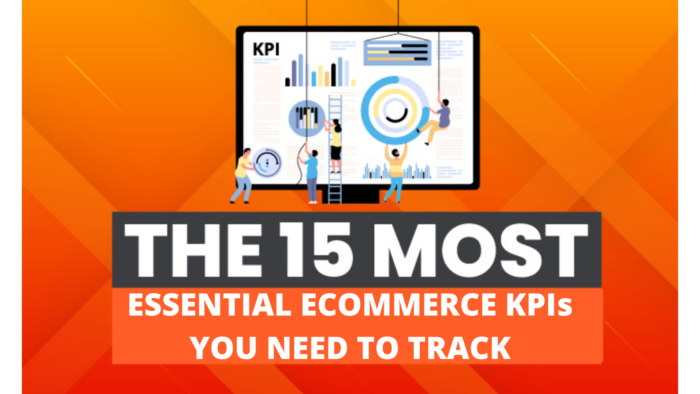
Building a successful e-commerce business isn’t easy.
Get it right, and you gain access to part of the 4.2 trillion in e-retails sales.
Get it wrong, and you could waste time and money on a store that doesn’t get results.
With the right e-commerce KPIs, you can trace, track, and quantify every store visit, customer journey, and sale to get unparalleled insight into your business.
An estimated 2.4 billion people shop online every year, to be successful, you need to track what’s working and what isn’t.
Armed with that data, you can optimize your store’s performance in a way that brick-and-mortar retail managers can only dream about.
There are so many things to track it can become overwhelming, however. How do you know which key performance indicators offer insight and which are vanity metrics?
In this article, I offer the guidance you’re looking for. You’ll learn what an e-commerce KPI is, how to work out which KPIs matter most to your store, and the 15 most important e-commerce KPIs I think every store should track.
If you’re ready, let’s begin.
What Are E-commerce KPIs?
Let’s start with the basics and clarify precisely what we mean by an e-commerce KPI.
KPI stands for key performance indicator. While the term is ubiquitous, futurist Bernard Marr believes it is “overused and misunderstood.” As a result, businesses rarely use them effectively.
Here’s how he defines KPIs:
In simple terms, KPIs provide a way to measure how well companies, business units, projects or individuals are performing in relation to their strategic goals and objectives.
In their broadest sense, KPIs provide the most important performance information that enables organisations (or their stakeholders) to understand whether or not the organisation is on track toward its stated objectives.
Over the next few years, e-commerce sales are expected to grow by 50 percent to about $7.4 trillion.
Monitoring several key performance indicators is essential for any e-commerce stores’ health and long-term success. Doing so helps you understand your business better, identify areas that are succeeding, and show where there’s room for improvement.
Okay, so what about KPIs concerning e-commerce stores?
E-commerce KPIs are simply the key performance indicators of your store. Given that the goal of almost every e-commerce store is to sell more products and generate higher revenue, e-commerce KPIs include net profit, average order value, and customer retention rate.
Track the right e-commerce KPIs, and you’ll be able to make better decisions about how to increase customers, drive more revenue, or achieve any other goal you have for your store.
Of course, there are many, many e-commerce-related indicators you could track. That’s why it’s essential to work out which matters most to your store.
How to Choose Which E-commerce KPIs Your Business Tracks
Not every e-commerce store will track the same set of KPIs. The ones important to your store’s success may not be the same as your competitors—it all depends on your goals.
If you’re not sure where to start when choosing KPIs, I’d recommend the following step-by-step approach.
1. Define Specific, Actionable E-commerce Goals
The first step to deciding which KPIs to track is defining your e-commerce store’s goals. Be as specific as possible when defining your goals. Don’t just state you want to increase site traffic, for instance.
State you want to increase organic traffic by 50 percent within six months.
You don’t have to have just one goal for your e-commerce store, either. Selecting two or three is absolutely fine and won’t hamper your ability to track e-commerce KPIs successfully.
Here’s a list of common e-commerce goals to get you started:
- increase site visits by X percent
- grow a product line by X customers or revenue
- Improve customer loyalty by reducing churn by X percent
- grow an email list to X subscribers
- increase revenue by X percent through upsells and cross-sells
Setting specific goals makes it easier to tell if you’ve reached your goals and helps you know which metrics to track.
2. Identify Relevant KPIs
Not every e-commerce KPI will help you meet your goals. So the next step is to find the most relevant KPIs. If your goal is to increase site traffic, for instance, then tracking your store’s bounce rate isn’t going to help. You’d be better off tracking your organic rankings, instead.
Ensure you choose suitable KPIs rather than vanity metrics by making sure they have the following four characteristics:
- measurable: If you can’t calculate your chosen KPI, you can’t track it.
- timely: KPIs need to be calculated in real-time and updated regularly.
- actionable: If you can’t take steps to improve your KPI, there’s no point tracking it.
- relevant: Is the KPI tied to at least one of the goals you chose above?
Finally, don’t go overboard when choosing KPIs. Track too many, and you’ll struggle to do anything meaningful with the data. Anywhere between three and five KPIs per goal is sufficient.
3. Track and Iterate
A recent study found those who track their progress towards meeting their goals are 40 percent more likely to achieve them.
Start tracking your KPIs as quickly as possible. The more data you have, the faster you’ll be able to spot patterns and start making improvements.
Then, use a tool like Google Data Studio to put your progress into a visual format.
Don’t worry if you aren’t tracking the right e-commerce KPIs straight away. Experimentation and reflection are part and parcel of identifying which KPIs to track.
Take an iterative approach to tracking KPIs and assess how successful you are every three months or so. Don’t be afraid to change them when you change your store’s goals, either.
The 15 Top e-Commerce KPIs to Track
Okay, so you know what e-commerce KPIs are and how to identify the ones most relevant to your business. Now let’s look at the top 15 e-commerce KPIs I recommend you track.
To be clear, you don’t need to track them all. Use this list with my guidance above to identify the ones that matter most and go from there.
1. Overall Sales
In 2021, e-commerce sales in the US topped $870 billion.
Every e-commerce store owner should be tracking sales figures on a daily, weekly, monthly, quarterly, and annual basis.
You can track this metric in two ways. The first is by monitoring the number of product units you sell. This is a sensible strategy for small e-commerce stores that only sell one or a handful of products.
If you have hundreds or thousands of SKUs on your site—and fixed costs are similar regardless of what you sell—track sales in terms of gross revenue instead. Gross revenue is the total sales revenue in dollars for a given period.
It may make sense to track both total sales and gross revenue together in some cases. Businesses who must hit a certain number of sales to qualify for third-party fulfillment discounts, for instance, may find this particularly useful. Tracking both will also show whether gross revenue growth results from more customers or higher average order values.
Your e-commerce platform will almost certainly have this KPI baked into its reporting dashboard, but you can also use Google Analytics to track sales figures.
2. Net Profit
The average net profit margin for online retail is 7.26 percent.
Your store’s net profit is a measure of your overall profitability. It’s the revenue you have left once you account for all of your expenses. Here’s how to calculate it:
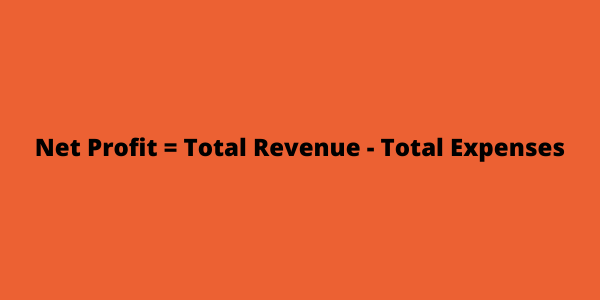
Calculating net profit on your own can be a little complicated, even if the equation is simple. Luckily, your bookkeeping platform will automatically display net profit on your company’s balance sheet and profit and loss statement.
Net profit is an excellent measure of your store’s health. If you’re turning a profit, then you’ve got an excellent foundation for growth and the bandwidth to invest in marketing initiatives to grow even further.
It can also show whether the tactics you’re using to boost sales are driving real value for the business. Tracking this metric in line with marketing strategies like discounts, special offers, and free shipping can show you to what extent a boost in conversions is impacting your bottom line. You may want to think twice about these strategies if it turns out they’re causing you to lose money.
You don’t have to track this metric as frequently as sales. Monthly, quarterly, and yearly are sufficient timescales.
3. Average Order Value
The average order value for e-commerce stores is $45.
Average order value (AOV) is the amount customers spend per order. You calculate it by dividing your total revenue by your total number of orders:
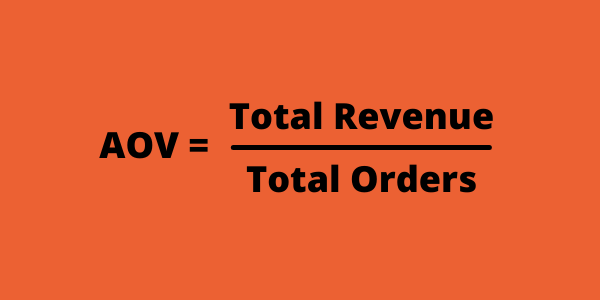
Like net profit, it’s best to track AOV monthly, quarterly, and annually. Your e-commerce platform should calculate AOV automatically. If not, Google Analytics e-commerce tracking solution will do it for you.
Average order value is typically one of the first metrics store owners look to track and increase. If you can increase your store’s AOV while keeping sales figures the same or higher, you’ll increase your store’s revenue. A higher AOV also means you’ll be able to stomach higher customer acquisition costs and offer additional incentives like free delivery without damaging your bottom line.
It’s important to note that AOV varies dramatically by industry, as this graph from Instasent shows.
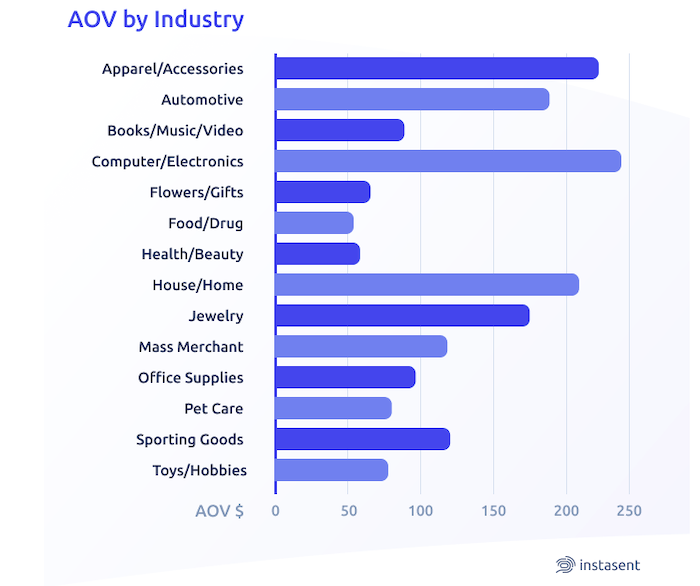
That’s why it’s important to focus on changes in your store’s AOV rather than comparing it to an industry average that is too broad to be of any use.
4. Number of Orders
According to a recent Metrilo study, 28 percent of customers order more than one item per purchase.
Your store’s number of orders is the total amount (not value) of orders taken over a given period. Typically, you’d track this monthly, quarterly, or annually.
Knowing how many orders customers are placing is essential for inventory management. You’ll be able to forecast warehouse space and product orders accurately. Tracking order volume over time will also show what impact changes to product pricing, quality, and other characteristics have on sales.
You needn’t look further than your store’s e-commerce platform to find this KPI. It may also be tracked by an inventory management tool if you use one.
5. Customer Lifetime Value
Per the Metrilo study, the average customer lifetime value for the industries they considered was $168.
Customer lifetime value (usually shortened to CLV, CLTV or LTV) measures how much the average customer will spend at your store over the length of their relationship with your business. It is, in essence, a measure of what customers are worth on average.
This particular e-commerce KPI can be a little tricky to calculate. We’ll use the simplest calculation, but you’ll still need to do a bit of homework. Before you begin, you’ll need to work out your average order value, the number of times customers buy from you on average each year, and your average customer retention. Then it’s a case of multiplying the averages.
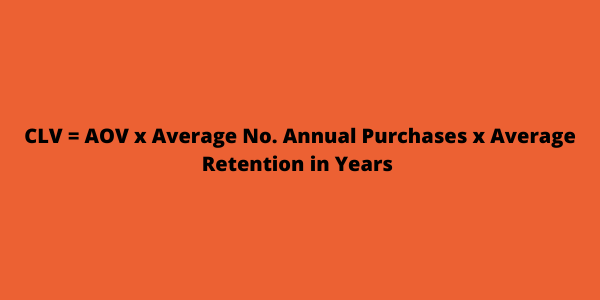
While it can be complicated to calculate CLV, it’s well worth doing so. It’s essential to understand how much each customer is worth to your business because it shows the level of return you’re getting on your customer acquisition cost.
It’s also a measure of how well your business retains customers. The higher your CLV relative to your AOV, the more frequently customers shop with you.
6. Customer Retention Rate
Your store’s customer retention rate is the percentage of customers who continue to shop with you over a period of time. You can measure it over a quarter, a year or even longer.
It’s easy to calculate. Just subtract the number of new customers acquired over a given period (N) from the total number of customers at the end of the period (E), divide that by the number of customers you had at the start of the period (S), and multiply everything by 100 to get a percentage:

By calculating your customer retention rate, you’ll know how well you’re serving customers and to what extent customers remain loyal.
This is another KPI that can vary wildly between stores. Some businesses like furniture companies, for instance, will have naturally lower customer retention rates owing to the nature of their products. Other stores—ones that offer subscriptions, say—will have naturally higher retention rates.
Unfortunately, customer retention rates in the retail industry are low in general. According to research by ProfitWell, retail CRR stands at 63 percent. That’s significantly lower than banking (75 percent), insurance (83 percent), and media (84 percent).
7. Traffic Volume
If you care about increasing sales, you’ll naturally want to track the amount of traffic your website receives. That’s what the traffic volume KPI measures.
Average traffic to e-commerce websites varies greatly. Monthly traffic to Amazon, for example, is 2.45 billion. Traffic to all e-commerce websites in January of 2022 was 17.1 billion.
Tracking traffic volume is easy with Google Analytics installed on your site. Head to Acquisition > All Traffic > Channels to see all of your site’s traffic over a given period broken down by acquisition channel.
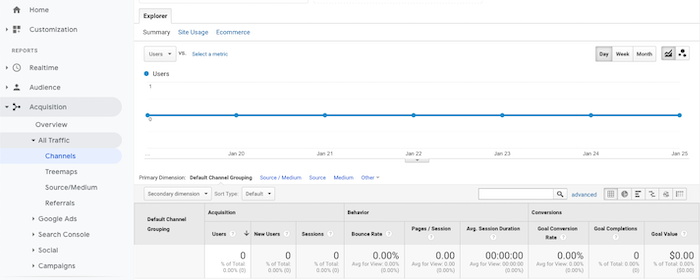
You can estimate some of your competitors’ traffic volumes with a tool like Ubersuggest. Type in a competitor URL, and you’ll see an estimate of their monthly organic traffic.

Monitor traffic volume on a weekly, monthly, quarterly, and yearly basis. You’ll probably find that traffic volumes spike during certain times of the year, like the holiday season, so tracking over longer periods can help you get a more accurate view.
8. Time on Site
Time on site is the average length of time visitors spend browsing your site before leaving. There’s no calculation needed for this KPI, either. Just head on over to Google Analytics, where it’s automatically calculated and displayed under Avg. Session Duration.
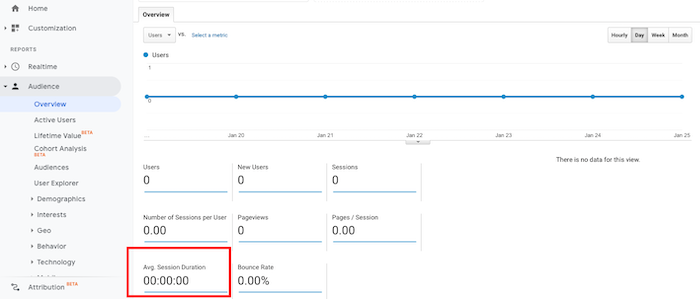
Like traffic volume, it’s best to track this KPI over a week, a month, a quarter, or annually.
Time on site is an excellent indicator of how engaging your store is. What’s more, the longer customers spend on your site looking at your products or reading your content, the more likely they are to make a purchase.
It won’t surprise you to know that some of the most engaging stores also have some of the highest browsing times. Amazon visitors spend a whopping 10 minutes browsing the site on average, compared to the 3.5 minutes Target visitors spend.
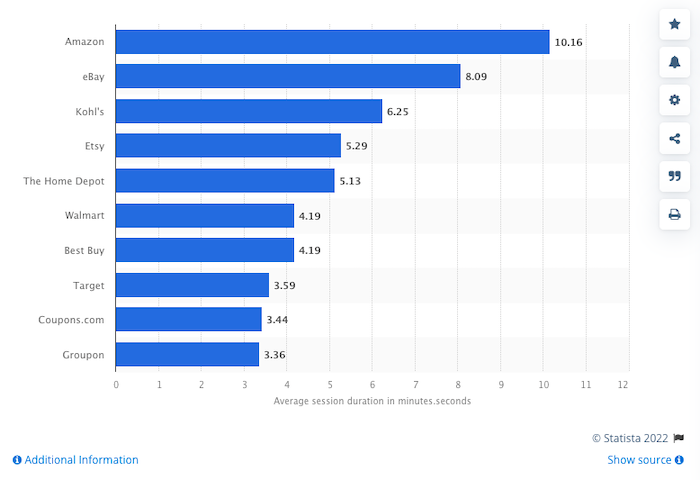
9. Conversion Rate
Your site may get a lot of visitors but how many of them are becoming customers?
That’s what your store’s conversion rate will reveal.
Your store’s conversion rate is the percentage of visitors who take a particular action.
You can calculate the conversion rate for things like email signups, but most store owners will want to know their purchase conversion rate.
Calculate it by dividing the number of orders by the number of visitors to your store, multiplying by 100 to get a percentage:
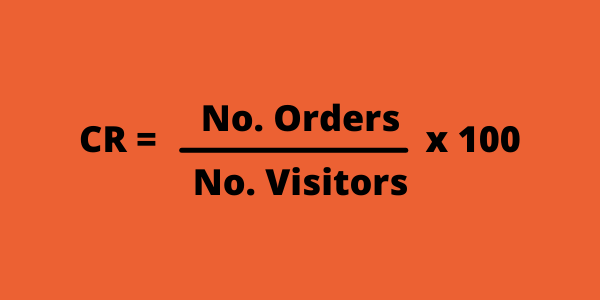
It’s important to note conversion rates vary drastically between stores. Luxury stores with expensive products will have much lower conversion rates than Amazon or Walmart, for instance.
The average conversion rate for online stores is 2.17 percent, but they can vary by industry as well as this graph from Growcode and IRP Commerce shows.
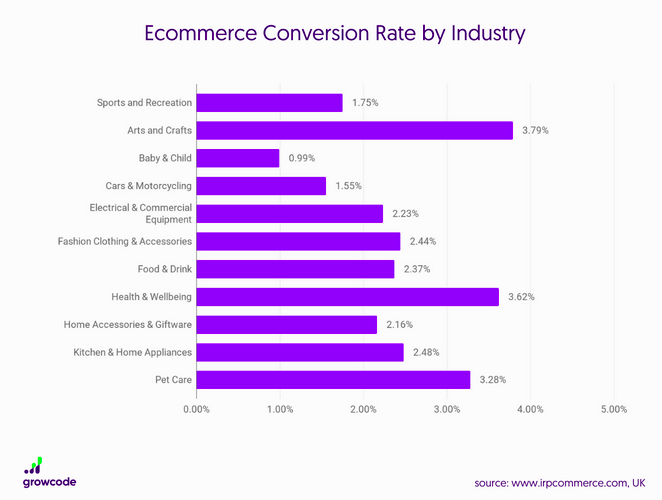
Your conversion rate can indicate several things like how engaging your site is, how optimized it is for conversions, and how attractive your products are. If you’re getting a lot of traffic, but they aren’t translating into sales, you may want to review your pricing or checkout experience.
10. ROAS
ROAS stands for Return on Ad Spend. It is a measure of how effective your marketing investment has been and shows how much you’ve earned for every dollar you’ve spent on advertising.
Calculating ROAS is simple. Just divide the revenue generated by an advertising campaign by the total cost of that campaign.
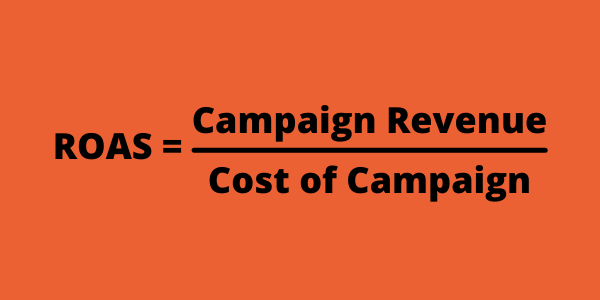
It’s rarely expressed as a figure, however. ROAS is usually shown as a ratio. So if you spent $1000 on an ad campaign that brought in $5000 worth of sales, you’d have a ROAS of 5:1.
According to WebFX, the average ROAS for Google ads is 200 percent or 2:1. If you can beat that, you’re doing very well.
A strong ROAS shows that your ads are very effective at bringing in high-paying consumers. In theory, spending more on ads will result in even more revenue. A weak or negative ROAS suggests you need to reduce advertising spend or increase conversion rates.
Once again, Google Analytics is your friend here. By tracking your digital marketing campaign through GA, you’ll be able to identify the customer journey of every visitor that clicks on your ad.
11. Cart Abandonment Rate
When visitors add items to their basket but leave your site without making a purchase, they’ve abandoned their cart. The cart abandonment rate KPI measures what percentage of shoppers do exactly that.
The average cart abandonment rate is around 77.13 percent, but varies by device, location, and industry—which is why tracking it is so important.
Optinmonster tracked average cart abandonment rates between 2006 and 2018. Not once did the figure dip below 60 percent, and it’s been trending upwards. The most recent average was 75.6 percent.
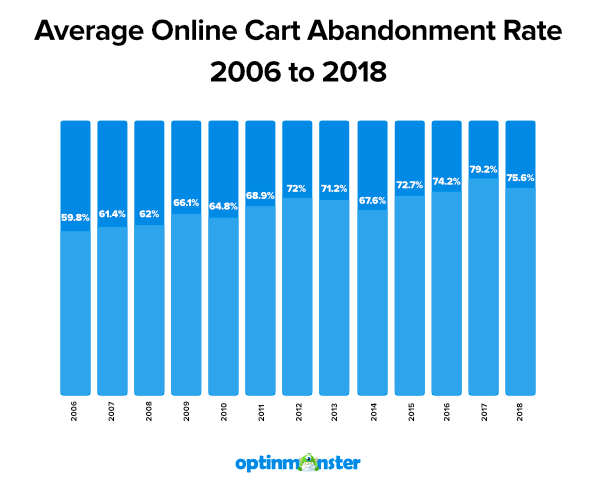
Because cart abandonment rates can vary widely, it’s best to track this KPI over longer periods. Either monthly, quarterly, or annually will suffice.
You can calculate this metric yourself, but your e-commerce platform should have this KPI on its reporting dashboard. Don’t be scared if you get a big number when running the calculation. Average cart abandonment rates are incredibly high.
It’s calculated by dividing the total number of completed purchases by the number of shopping carts created and multiplying by 100 to get a percentage.
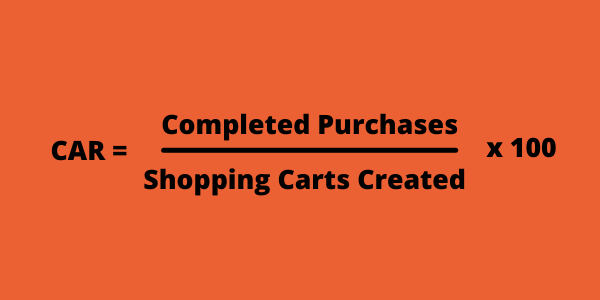
There are many reasons shoppers abandon their carts. It could be because of high shipping costs, a lack of payment options, or a complex checkout process. Sometimes, visitors just aren’t ready to buy. You can’t stop people from abandoning their cart completely, but it’s a lot easier to take action when you know your cart abandonment rate is rising.
12. Customer Acquisition Cost (CAC)
The average CAC via organic sources in the B2B e-commerce industry is $87. For non-organic sources, it’s $81.
Customer acquisition cost (CAC) is how much it costs to acquire a new customer. This KPI is usually tied to advertising campaigns. So let’s say you spent $2000 on an ad campaign that resulted in 100 new shoppers. You’d have a CAC of $20.
As you can see, it’s relatively easy to calculate your CAC for specific campaigns. You just divide the total amount spent on acquiring customers by the total number of new customers.
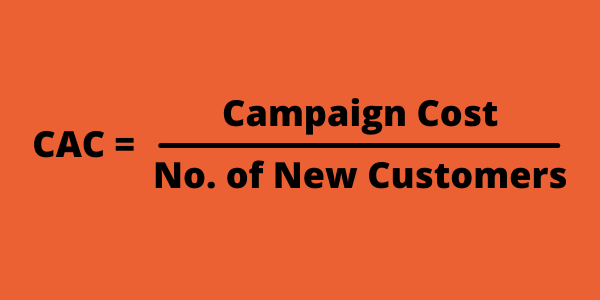
Knowing your CAC is essential if you want to run successful marketing campaigns. Because your average sale price will probably stay reasonably similar (unless you launch new products), your CAC can determine just how profitable your store is. A lower CAC means more profit.
It also lets you plan campaigns better. If you want to acquire a certain number of customers and know how much each one will cost, for instance, it’s a lot easier to allocate a budget.
13. Organic Search Rankings
One of the best ways to lower your overall customer acquisition cost is to generate traffic volume without paying for it. 33 percent of traffic to e-commerce websites is from organic search. That’s the power of SEO and the reason it’s important to track your site’s organic search rankings.
There’s no shortage of ways to improve your store’s organic rankings, as my article on the topic shows. But to improve your rankings, you first need to know what they are.
For that, I recommend Ubersuggest. It will show the current position of all the keywords your site is ranking for.
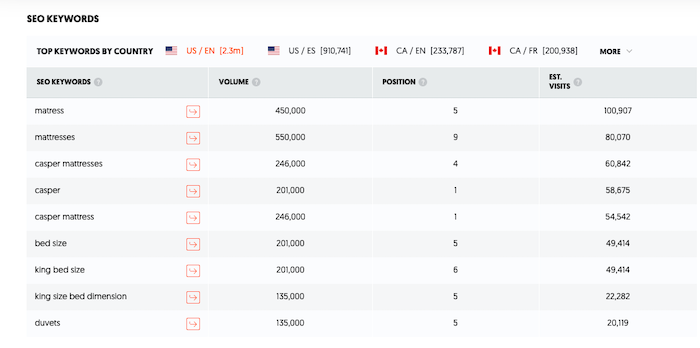
It will also suggest more keywords you should target moving forwards. Head over to the Keyword Ideas tab, enter your domain, and Ubersuggest will serve up a buffet of keywords to choose from.
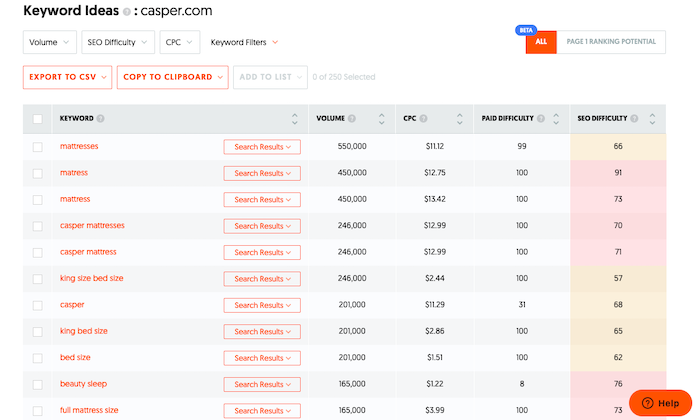
14. Add to Cart Rate
What sort of add-to-cart rate should you be aiming for? Databox surveyed e-commerce professionals and the most common answer was 3-4%.
Add to cart rate is the percentage of customers who place an item in their cart while browsing.
It’s calculated by dividing user sessions when an item is added to a cart divided by total sessions.
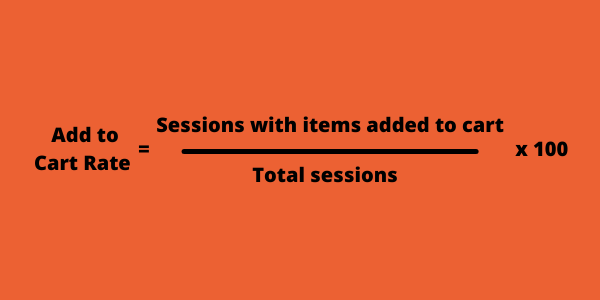
It’s important to track your store’s add-to-cart rate alongside cart abandonment rate and number of orders. The other two stats become less relevant if users aren’t adding products to a cart, to begin with.
Your store’s add to cart rate shows how successful your product selection is, the quality of your product descriptions, and your site’s usability. If you upgrade any of these factors, you should expect to see your add to cart rate increase.
15. Customer Satisfaction
On a scale of 1-100, the average customer satisfaction rate in the last quarter of 2021 was 73.3.
Are your customers happy with your shopping experience? High sales and low cart abandonment rates may suggest everything is rosy, but you never know for sure unless you calculate your customer satisfaction score.
A survey is a great way to measure customer satisfaction, and it’s best to do it immediately after purchase or delivery when the customer is most likely to respond. A simple question like “How satisfied were you with your experience?” followed by a scale from one to five will suffice.
Your CSAT is the sum of all the 4 and 5 scores divided by the total number of respondents x 100.
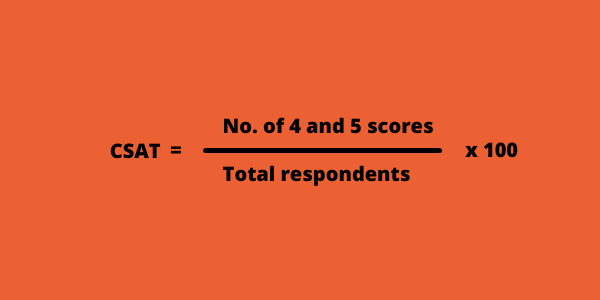
You don’t have to stop there, however. Use your CSAT as a jumping-off point and follow up with customers who rated the experience poorly. Qualitative feedback may shed light on how you can better engage customers.
E-Commerce KPIs Frequently Asked Questions
What are the top 3 most commonly used e-commerce KPIs?
Site traffic, average order value and customer lifetime value are three of the most commonly tracked e-commerce KPIs.
What is the best tool for tracking e-commerce KPIs?
Your e-commerce platform, Google Analytics, and an SEO tool like Ubersuggest are the best tools to track e-commerce KPIs.
How often should I be measuring my e-commerce businesses' KPIs?
How often you track KPIs depends on the metrics you use. Some, like total sales, can be tracked every day. Others like conversion rate or cart abandonment rate are better tracked over a week, a month, or a quarter.
How do you find good objectives for e-commerce KPIs?
Find good objectives for e-commerce KPIs by focusing on your store goals. To get more traffic, focus on traffic-related KPIs like organic rankings. If you want to sell more products, focus on conversion rates and cart abandonment rates instead.
Conclusion: E-commerce KPIs
Tracking the right KPIs can be the difference between the success and failure of your e-commerce store. The wrong metrics will have you shooting in the dark. But it becomes a whole lot easier to optimize your business when you have the right data at your fingertips.
The sheer number of e-commerce KPIs can be overwhelming, however. That’s why it’s so important to work out which KPIs actually matter and focus on them and them alone.
After identifying your goals and researching and setting your benchmarks, make sure you continually track and iterate as needed on yoru goals.
Which e-commerce KPIs are you currently tracking? Let me know in the comments!
from Neil Patel's Digital Marketing Blog https://ift.tt/QgapbM8

No comments:
Post a Comment